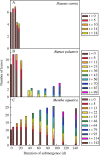Underwater photosynthesis in flooded terrestrial plants: a matter of leaf plasticity
- PMID: 16024559
- PMCID: PMC4247027
- DOI: 10.1093/aob/mci212
Underwater photosynthesis in flooded terrestrial plants: a matter of leaf plasticity
Abstract
Background: Flooding causes substantial stress for terrestrial plants, particularly if the floodwater completely submerges the shoot. The main problems during submergence are shortage of oxygen due to the slow diffusion rates of gases in water, and depletion of carbohydrates, which is the substrate for respiration. These two factors together lead to loss of biomass and eventually death of the submerged plants. Although conditions under water are unfavourable with respect to light and carbon dioxide supply, photosynthesis may provide both oxygen and carbohydrates, resulting in continuation of aerobic respiration.
Scope: This review focuses on evidence in the literature that photosynthesis contributes to survival of terrestrial plants during complete submergence. Furthermore, we discuss relevant morphological and physiological responses of the shoot of terrestrial plant species that enable the positive effects of light on underwater plant performance.
Conclusions: Light increases the survival of terrestrial plants under water, indicating that photosynthesis commonly occurs under these submerged conditions. Such underwater photosynthesis increases both internal oxygen concentrations and carbohydrate contents, compared with plants submerged in the dark, and thereby alleviates the adverse effects of flooding. Additionally, several terrestrial species show high plasticity with respect to their leaf development. In a number of species, leaf morphology changes in response to submergence, probably to facilitate underwater gas exchange. Such increased gas exchange may result in higher assimilation rates, and lower carbon dioxide compensation points under water, which is particularly important at the low carbon dioxide concentrations observed in the field. As a result of higher internal carbon dioxide concentrations in submergence-acclimated plants, underwater photorespiration rates are expected to be lower than in non-acclimated plants. Furthermore, the regulatory mechanisms that induce the switch from terrestrial to submergence-acclimated leaves may be controlled by the same pathways as described for heterophyllous aquatic plants.
Figures



References
-
- Adkins SW, Shiraishi T, McComb JA. 1990. Submergence tolerance of rice—a new glasshouse method for the experimental submergence of plants. Physiologia Plantarum 80: 642–646.
-
- Allen ED, Spence DHN. 1981. The differential ability of aquatic plants to utilize the inorganic carbon supply in the fresh waters. New Phytologist 87: 269–283.
-
- Armstrong W. 1979. Aeration in higher plants. In: Woolhouse HW, ed. Advances in botanical research. London: Academic Press, 226–328.
-
- Armstrong W, Gaynard TJ. 1976. The critical oxygen pressures for respiration in higher plants. Physiologia Plantarum 37: 200–206. - PubMed
-
- Armstrong W, Brändle R, Jackson MB. 1994a. Mechanisms of flood tolerance in plants. Acta Botanica Neerlandica 43: 307–358.
Publication types
MeSH terms
Substances
LinkOut - more resources
Full Text Sources
Research Materials

